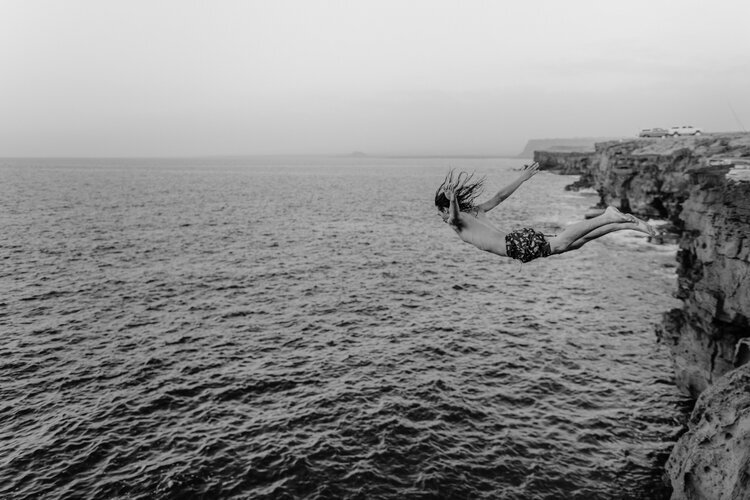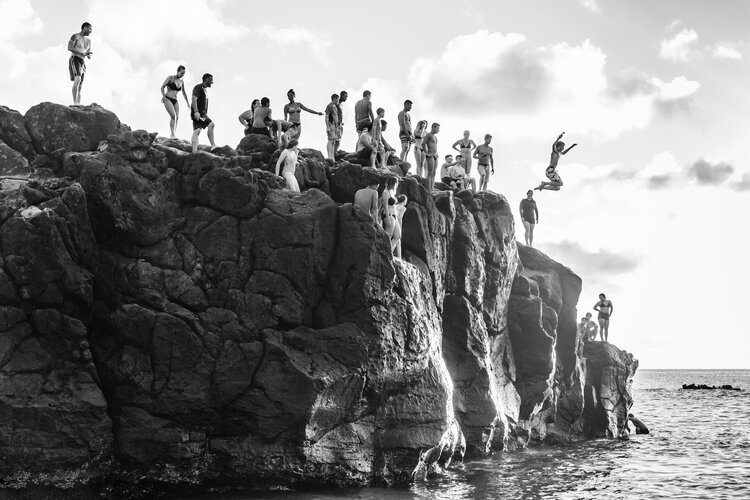Capturing High Diving Pictures With Lukas Griffin
Capturing adventurous moments that exhaust exhilaration and excitement on camera are my favorite kind of images to take. Typically, on a shoot, I hold my camera steady, making myself ready to take my next shot, but it is only when I can feel the image, that I seize that very moment in time.
My images represent the exterior landscape, meeting the lives of the individuals living fully within them. It could be considered impossible for a human being to live their life to the fullest every single day of their lives, but the moments that I capture with my camera are significant. The people in them are living to their fullest, as they experience that glimpse of exasperation.
I enjoy shooting many types of photography, but one of my most adorned types of adventurous shots to capture are cliff jumping images. So, in light of this, I am going to share three of my favorite spots for shooting high diving pictures with you all in today’s article.
South Point - Many come here to stand atop the rocky cliffs and look out at the views of the vast Pacific Ocean, which continue all the way along from South Point to Antarctica. For many years it’s been a common practice for those seeking a thrill to jump from the 40-foot cliffs into the crystal-clear blue water below.
There are several spots for your subject to jump into the water at South Point - Big island, Hawaii. Of course, it is up to you whether you’d like to stand along the cliff’s edge from an angel to shoot the diver going down into the water from a higher perspective, or if you’d like to place yourself in the water below to get the shot. Most people tend to jump near the canoe launches, as the water level is 25 ft deep, right off of the shore. There is also a metal ladder which you can climb up to get back to the top again if you need to change levels for different captures.
Personally, I decided to stay above water level, as conditions at South Point can get rough and dangerous. It’s also worth noting that South Point also has more shark sightings from land than anywhere else in the state of Hawaii. Great White and Tiger Sharks are often encountered offshore in this location. However, if you do decide to brave the waters below, it’s best to stay at least 20 feet from the rocky cliff wall, otherwise breaking waves may sweep you into the rocks.
For those that come to Big Island seeking adventure, jumping from the cliffs at south point can be a life changing experience. If you’re in any way unsure of your abilities you may want to keep to dry land, but for the adventurous few there is little better than that brief moment of flight before hitting the water.
Bonsai Rock - This rock is a granite boulder in the middle of a sheltered swimming cove on the eastern shore of Lake Tahoe. Today, it remains slightly less popular compared to other cliff jumping spots in the area. However, this is largely due to the lack of official parking and signage to the spot. So, it’s always worth doing your research if you’re planning a shoot. You may just end up embarking on a journey that will lead you to hidden photographic possibilities.
As I’ve mentioned previously here on my journal, I always like to carry out a little research before venturing out into a shoot. I like to feel prepared, knowledgeable of the location before I arrive at my destination of choice. However, I actually knew of Bonsai Rock as a shooting spot before digging deeper into Lake Tahoe’s cliff jumping options.
Having read up on this landmark sufficiently before heading out to capture my collection of pictures, I decided to call upon a friend who had experience with diving to be the subject for my shoot. For shapes and poses, I took inspiration from the many high diving pictures I found online which were taken at Bonsai Rock. I just remember thinking that it seemed like a really cool location for me to take my camera and underwater housing equipment for a shoot.
A polarizing filter is also a must if you want to cut through those water reflections and a powerful ND filter will help you out hugely if the waves are choppy. You’ll be able to walk away with images that contain controlled water motion for crisper shots. The ND filter will also allow you to shoot for longer exposures in brighter lighting which is always an interesting effect.
I would highly recommend visiting this destination in the summer months as the low tide will expose more of the white sand and smaller rocks. This will also give you more foreground options, giving Bonsai Rock a little more height. From experience, I would suggest getting your feet wet to capture better high diving pictures in this location, however I would not recommend doing this in the winter. If you’re planning a trip during the warmer months of the year, pack some flip flops in your camera bag so can wear them in the water for some grip on those rocks.
Rember that if it takes a couple of attempts to get the images you were aiming for, that is not a big deal at all. Many professional photographers don’t walk away with the best images in hand on their first attempt at shooting in a new destination. Whenever you’re out shooting, you may have to persevere. I can remember when I went out shooting Bonsai, it did take me a few attempts to feel happy with the images I’d captures. Bonsai - Bonsai Rock, Lake Tahoe is actually my most favorite image, out of all the shots I have ever taken.
In terms of positioning and where your subject should dive, look for the boulders sheltering the cove. This is a good place for your subject to jump from. With underwater housing, you can capture the action above the surface, alongside the cool blue waters below. There is even an area to cliff jump into the lake from the southeastern side of Bonsai Rock.
Despite the lack of a beach at this destination, there is actually a fair amount of sand in the cove itself. So, perhaps this could be an includable feature in your high diving pictures? Please note that water levels in this spot can become dangerously shallow during certain times in the year. Caution should always be exercised where cliff jumping is concerned, no matter the location.
Waimea Bay - If you drive an hour northward from downtown Honolulu, you will find yourself in Waimea Bay Beach Park on the North Shore Oahu. With crystal-clear aquamarine waters and cliffs that are approximately 10 meters in height, the location’s calm ocean surface and powdery white sand presents Waimea Bay as the perfect spot to capture a collection of high diving pictures.
Like the other locations above, the best time to visit this destination would be during the summer months. This is usually when waters are at their calmest. If this is indeed the case on the day of your visit, I would suggest pointing your subject in the direction of the rocky cliffs next to the beach. This area of the bay makes for an excellent cliff jumping spot. You will be able to capture some awesome shots from the beach and water.
Of course, you could even climb up to the top of the rock with your camera and take some shots of the cliff jumpers below. On the rock it is very likely that you will see a line of people waiting to take their plunge. You will find the easiest climb to the back left of the formation. Proceed across the rocks to the front right where the waters become deep enough for your subject to jump.
Waimea Bay has played host for many of my cliff jumping images. One of my favorite captures taken here is G’Day - Waimea Bay, Hawaii, which can be seen above.
So, that concludes my guide cliff diving photography. I hope that you have found this article both intriguing and useful from a photography standpoint.
On the other hand, if you’re an art curator, looking to expand the collection of high diving pictures in your home, you can view the artworks featured within this article using the links provided.
If you’d like to keep up to date, feel free to visit my Instagram page @lukasgriffin for further examples of my photography work.
PHOTO CREDITS
All photos used within this article are courtesy of Lukas Griffin.
All images are available to purchase as prints, view all collections.




